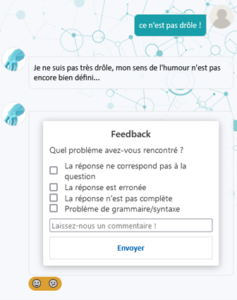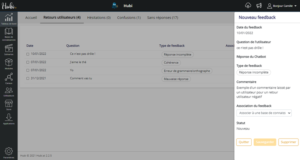“Did I respond correctly to your question?”, “Are you satisfied with my answer?”, “What should I do to improve?”, “What do you think of my response?”…
How many times have you read this type of question while talking to a chatbot? Although chatbots are becoming increasingly present in our lives, developers of virtual agents are constantly seeking to improve them in order to provide a high-quality product to the users.
Through the reading of this article, you will find out what user feedbacks are and how it is used to determine areas of improvement for chatbots!
What is the difference between user feedbacks and customer satisfaction?
User feedbacks are a feature that allows users to send their review on their experience with the chatbot. These feedbacks are intended to help managers, and sometimes even the creators of a chatbot, to determine the areas of improvement of their conversational assistant.
In most cases, gathering user feedback is done through customer satisfaction. However, customer satisfaction refers to a quite simple type of user feedbacks that does not provide any precise information. It only allows to determine if the users are satisfied or not with their interaction with the chatbot, no more and no less. A chatbot can collect users’ satisfaction at the end of the conversation or at each answer that the virtual agent gives…However, this repetitiveness can quickly become annoying!
In a “traditional” customer satisfaction survey, customer satisfaction is usually collected through close-ended questions such as “Did I answer your question correctly?”, “Are you satisfied with my answer?”, “What do you think of my answer?”. This type of question, for which the only possible answers are often “yes” or “no”, does not give the users the opportunity to explain why they are satisfied or not with the service.
Although customer satisfaction is a key factor, it would be even more relevant if users could express themselves freely on the subject. In some surveys, questionnaires collect customer satisfaction and ask users to leave a comment to explain their answer. This type of user feedback is much more significant as it provides a detailed explanation of the users’ satisfaction or dissatisfaction. It is those feedbacks that help determine areas of improvement and actions to be taken to further develop the chatbot and meet the users’ needs.
How do user feedbacks work with Hubi.ai?
With Hubi.ai, user feedback is focused on the content and behaviors of the bot at a given time. Each response from the bot can be the subject of a feedback. Customer satisfaction is therefore not collected at the end of the conversation with the chatbot.
User feedbacks are represented by two emojis in the chat window:
- A smiling face to send positive feedback
- A sad face to send negative feedback.

These emojis are associated with a traditional satisfaction survey. However, they are less invasive: users are free to click or not on one of the emojis. It is up to the user to give feedback on their experience with the bot.
For now, positive feedbacks do not allow to leave a comment. They only allow to collect the satisfaction with the response provided by the bot. In other words, the smiling emoji only indicates that the user is satisfied with the response the bot has given them.
How to use user feedback with Hubi.ai?
On the other hand, the sad emoji leads to a form. Thus, the user can specify the reasons for their discontent using the predefined answers and/or the comment section, in which they can freely express their concerns.

How to use user feedback with Hubi.ai?

Negative feedbacks are uploaded to the Hubi.ai portal associated to your bot. They contain the following information: date, the users’ question, the type of feedback and the users’ comment. These elements provide enough content to analyze the returns: all that is left to do is to sort them, assign them, process them, close them, or delete them.
If you want to learn more about Hubi.ai contact us for more information!
